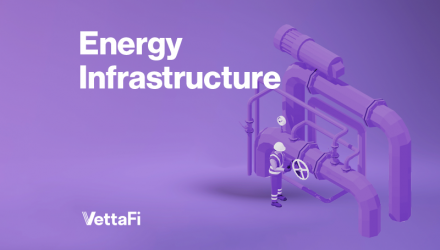- Renewable natural gas (RNG) is biogas produced from the decomposition of organic materials that has been purified to meet quality standards.
- Like other alternative energies, RNG enjoys certain incentives and tax advantages that boost its economics, including provisions in the Inflation Reduction Act.
- Given government incentives and the drop-in compatibility of RNG, midstream companies are investing in interesting RNG production projects.
Solar and wind tend to dominate narratives around alternative energy, but there are other compelling solutions for decarbonizing our energy sources, including renewable natural gas (RNG). RNG has perhaps gained more attention over the last several months, given incentives included in the Inflation Reduction Act and bp’s (BP) $3.3 billion acquisition of U.S. RNG producer Archaea Energy announced in October. Energy infrastructure companies are well positioned to participate in RNG opportunities, given that RNG is fully compatible with existing natural gas infrastructure. Today’s note provides an overview of RNG, the incentives that are supporting production growth, and three interesting ways midstream companies are participating in RNG production.
Renewable Natural Gas 101
RNG is biogas produced from the decomposition of organic materials that has been purified to meet quality standards. Its environmental value is two-pronged: Not only does its consumption replace that of conventional natural gas, but it also makes use of sequestered greenhouse gases that would otherwise contribute to pollution. Sources of biogas include landfills, cow manure from livestock facilities, wastewater treatment plants, and other businesses that generate organic waste. RNG can be used for electricity generation or as a transportation fuel (as compressed natural gas or liquefied natural gas) for natural gas vehicles. It can be stored and transported in the same way with the same infrastructure as conventional natural gas.
Incentives and Tax Credits for RNG
Like other alternative energies, RNG enjoys certain incentives and tax advantages that boost its production economics. The Inflation Reduction Act (IRA) made qualified biogas facilities eligible for the Section 48 investment tax credit (ITC) if construction starts before 2025. The ITC has a baseline rate of 6% of certain costs of the project but can go up to 30% if wage and apprenticeship parameters are met. RNG used for power generation is eligible for a production tax credit (PTC), which the IRA extended. Note that a facility cannot claim both an ITC and PTC. The IRA also extended the $0.50 per gallon Alternative Fuel Credit through the end of next year for those producing RNG to be used as a transportation fuel.
RNG can also generate Renewable Identification Numbers (RINs) and credits under the Low-Carbon Fuel Standards (LCFS) adopted by some West Coast states. RINs and LCFS credits can be sold to parties that are obligated to comply with the Renewable Fuels Standard and LCFS. When used as a transportation fuel, RNG can generate two types of RINs, which were priced at $1.57 and $1.94 per gallon in mid-April. The EPA has also proposed including RINs in the Renewable Fuel Standards for the next three years, which would apply to RNG used to generate electricity that charges electric vehicles. Earlier this month, California LCFS credits were priced on average at around $75 per metric ton of carbon dioxide reduced.
3 Cool Ways Midstream Companies Are Participating in RNG Production
With these incentives and the drop-in compatibility of RNG, it’s not surprising that midstream companies are investing in RNG production. Three interesting examples are highlighted below, but this is by no means an exhaustive list of ways midstream companies are positioning for RNG growth.
In August 2021, Kinder Morgan (KMI) completed the acquisition of Kinetrex Energy — a leading supplier of liquefied natural gas in the Midwest with a burgeoning RNG business using gas from landfills. With subsequent acquisitions, KMI’s current RNG assets are expected to be able to produce ~7.4 billion cubic feet gross of natural gas annually as facilities come online.
TC Energy (TRP CN) announced a $29 million investment in an RNG facility near the Jack Daniel Distillery in Tennessee last October. Expected online in 2024, biogas from the distilling process will be upgraded to RNG that will directly connect to a local natural gas utility. The facility will also produce liquid fertilizer. TC Energy will market all the RNG produced, along with environmental credits including RINs and LCFS credits.
Last month, Enbridge (ENB CN) announced that it was taking a 10% stake in Divert Inc. for $80 million. Divert manages food waste from major retailers and has expanded into RNG. In fact, BP signed a 10-year offtake agreement with Divert in October for RNG from three of its facilities. The agreement with Enbridge includes the potential to invest more than $1 billion to develop wasted-food-to-RNG facilities throughout the U.S., which would have long-term take-or-pay contracts.
Through these initiatives and many others, U.S. production of RNG is expected to see significant growth in coming years, albeit volumes will likely remain modest relative to overall U.S. natural gas demand. KMI’s analyst day presentation included a chart forecasting total U.S. RNG production of 3.2 billion cubic feet per day (Bcf/d) in 2050, which would be up from 0.2 Bcf/d in 2022. For context, the U.S. consumed 88.5 Bcf/d of natural gas in 2022.
What’s the Takeaway for Midstream Investors?
Midstream companies continue to position for a cleaner energy future with RNG investments providing relevant examples of growth opportunities in alternative energy. Many investors tend to think the changing energy landscape is all about solar and wind power, but that is arguably too narrow a view. If RNG can be made from the byproducts of whiskey distillation, spoiling food, and trash, what surprising energy sources will we be talking about 10 years from now?
For more news, information, and analysis, visit the Energy Infrastructure Channel.
Related Research:
Midstream/MLPs Advance Clean Energy Initiatives
Midstream Leveraging Current Assets in the Energy Transition
Midstream Partnering for a Cleaner Tomorrow
Can Midstream/MLPs be a Green Investment?

